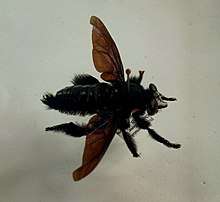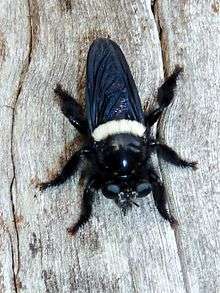Hyperechia
Hyperechia is a genus of robber flies in the family Asilidae. They appear large, stout and with legs covered in bristles and appear like carpenter bees in the genus Xylocopa and the resemblance is considered as a case of aggressive mimicry, providing protection from predators. The larvae of the fly feed on the larvae of Xylocopa within their cavity nests in wood.[1] They are mainly found in the African and Madagascan region with about 15 species and two species in Asia.[2][3]
| Hyperechia | |
|---|---|
 | |
| Hyperechia xylocopiformis from India | |
| Scientific classification | |
| Kingdom: | Animalia |
| Phylum: | Arthropoda |
| Class: | Insecta |
| Order: | Diptera |
| Family: | Asilidae |
| Subfamily: | Laphriinae |
| Genus: | Hyperechia Schiner, 1866 |
| Type species | |
| Hyperechia xylocopiformis (Walker, 1849) | |
Taxonomic description

These robberflies are large with a broad abdomen, with long and dense hairs on the femora, tibiae and basal tarsus segments of the leg. The head is wide. The wing is broad at the base and tapered at the tip. The body is 22 to 35 mm long. The palps ofhave the second segment large, thin and leaflike with bristles on the top. The antennae have a stout basal segment that is longer than the next which is knob-like at the distal end. The third antennal segment is elongated and slender widening towards the middle and becoming spindle shaped. The frons is short and shiny.[4][5]
Species in the genus include:
- Hyperechia bifasciata Grünberg, 1907
- Hyperechia albifasciata (Enderlein, 1930)
- Hyperechia bomboides (Loew, 1851)
- Hyperechia consimilis (Wood, 1874)
- Hyperechia marshalli Austen, 1902
- Hyperechia madagascariensis (Enderlein, 1930)
- Hyperechia nigripennis (Wiedemann, 1830)
- Hyperechia floccosa (Bezzi, 1908)
- Hyperechia fuelleborni (Grünberg, 1907)
- Hyperechia hirtipes (Fabricius, 1805)
- Hyperechia imitator (Grünberg, 1907)
- Hyperechia nigrita (Grünberg, 1907)
- Hyperechia pellitiventris (Enderlein, 1930)
- Hyperechia xylocopiformis (Walker, 1849) from India
- Hyperechia fera (Wulp, 1872) from Borneo
References
- Poulton, Edward B. (1924). "VI. The relation between the larvae of the Asilid genus Hyperechia (Laphriinae) and those of Xylocopid bees". Transactions of the Royal Entomological Society of London. 72 (1–2): 121–133. doi:10.1111/j.1365-2311.1924.tb03352.x.
- Bruggen, A.C. Van (1962). "A preliminary note on the genus Hyperechia Schiner in Africa (Diptera : Asilidae)". Journal of the Entomological Society of Southern Africa. 25 (2): 313–317.
- Kannan K. (1925). "Xylocopa and Hyperechia in India". Proceedings of the Entomological Society of London: 12–13.
- Hull, Frank M. (1962). "Robber Flies of the World: The Genera of the Family Asilidae. Part I" (PDF). Bulletin of the United States National Museum. 224: 1–907. doi:10.5479/si.03629236.224. hdl:2027/mdp.39015006168440.
- Oldroyd, Harold (1974). "An introduction to the robber flies (Diptera: Asilidae) of Southern Africa". Annals of the Natal Museum. 22 (1): 1–171.